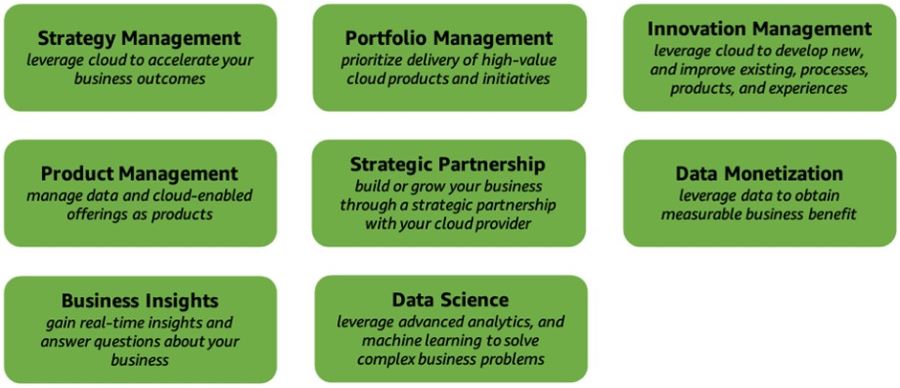|
Now, let's dive deeper into the specific capabilities that comprise the Business Perspective: Strategy and Outcomes. Within this perspective, there are eight key capabilities that play a crucial role in aligning your cloud strategy with your long-term business goals. From strategy management and portfolio prioritization to innovation, product management, strategic partnerships, data monetization, business insights, and data science, each capability offers unique insights and strategies to maximize the value of your cloud investments. By understanding and effectively implementing these capabilities, organizations can gain a competitive edge, foster innovation, and transform their operations to thrive in today's dynamic business landscape. So, join us as we explore the Business Perspective: Strategy and Outcomes, and discover how these capabilities can empower your organization to achieve its digital transformation goals and drive measurable business success. Let's dive into the first capability within the Business Perspective The business perspective within the AWS Cloud Adoption Framework (AWS CAF) focuses on leveraging your cloud investments to accelerate your digital transformation ambitions and drive tangible business outcomes. This perspective comprises eight key capabilities that are essential for success. Common stakeholders include the CEO, CFO, COO, CIO, and CTO. Figure 1: AWS CAF Business perspective capabilities Strategy Management Harness the power of the cloud to support and shape your long-term business goals. Identify opportunities to optimize technology and business operations, explore new cloud-enabled value propositions and revenue models, and prioritize strategic objectives. Evolve your strategy over time in response to technological advancements and changes in your business environment. Portfolio Management Prioritize cloud products and initiatives in alignment with your strategic intent, operational efficiency, and capacity to deliver. Utilize automated discovery tools and migration strategies (known as the 7 Rs) to rationalize your application portfolio and build a data-driven business case. Balance your cloud portfolio by considering short-term and long-term outcomes, as well as low-risk and higher-risk opportunities. Innovation Management Leverage the cloud to develop and improve processes, products, and experiences. By instantly provisioning and shutting down resources, the cloud can reduce time-to-value and innovation-related costs and risks. Develop an innovation strategy that combines incremental and disruptive initiatives to optimize existing offerings and enable new business models. Implement mechanisms for idea solicitation, selection, and scaling successful innovation pilots. Product Management Manage data- and cloud-enabled offerings as products throughout their lifecycles, delivering repeatable value to internal and external customers. Organize teams around these products to enhance agility and customer-centricity. Establish small, cross-functional teams, identify product owners, define roadmaps, and manage end-to-end lifecycles. Leverage the cloud platform and agile methods to iterate rapidly and reduce dependencies between teams. Strategic Partnership Build or grow your business through strategic partnerships with your cloud provider. These partnerships can help you enhance your cloud expertise, promote your solutions, and drive successful customer engagements. Take advantage of promotional credits, funding benefits, and co-selling opportunities. Leverage your cloud provider's marketplace channel and technical resources to expand reach and mature your cloud-based products and services. Data Monetization Unlock the value of data to achieve measurable business benefits. The cloud enables collection, storage, and analysis of vast amounts of data. Develop a comprehensive data monetization strategy aligned with your strategic intent. Identify opportunities to leverage data and analytics for improving operations, customer and employee experience, decision-making, and enabling new business models. Monetize data internally before exploring external monetization options. Business Insights Gain real-time insights and answer critical business questions. Descriptive insights enable you to track performance, improve decision-making, and optimize operations. Establish cross-functional analytics teams with a deep understanding of the business context. Align analytics efforts with business goals and KPIs. Leverage the Data Catalog, visualization tools, and techniques to discover trends and patterns. Focus on the big picture first and drill down as needed. Data Science Utilize experimentation, advanced analytics, and machine learning to solve complex business problems. Predictive and prescriptive analytics can enhance operational effectiveness, decision-making, and customer and employee experience. Ensure your Data Catalog contains the necessary data products for building and testing machine learning models. Implement CI/CD practices for operational resilience. Understand model predictions and identify potential biases. Deploy models to production and monitor performance. By embracing these business capabilities within the AWS CAF, you can align your cloud investments with your strategic objectives, drive innovation, and unlock the full potential of the cloud to achieve tangible business outcomes. SummaryThe Business Perspective plays a pivotal role in leveraging cloud investments to accelerate digital transformation and drive business success. Embracing the Business Perspective empowers organizations to become more agile, customer-centric, and competitive in the rapidly evolving digital landscape. By leveraging the potential of cloud technologies and adopting a strategic approach to cloud adoption, businesses can drive operational efficiency, improve decision-making, enhance customer experiences, and unlock new revenue opportunities. As we continue our exploration of the AWS CAF, stay tuned for the upcoming articles in this series, where we will delve into the remaining perspectives: People, Governance, Platform, Security, and Operations. Each perspective provides unique insights and strategies that are essential for a successful cloud transformation journey.
0 Comments
Leave a Reply. |
AuthorTim Hardwick is a Strategy & Transformation Consultant specialising in Technology Strategy & Enterprise Architecture Archives
June 2023
Categories
All
|
Site powered by Weebly. Managed by iPage



